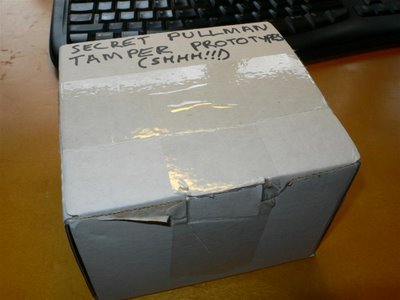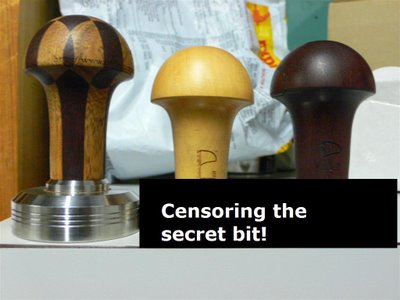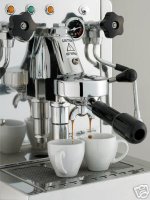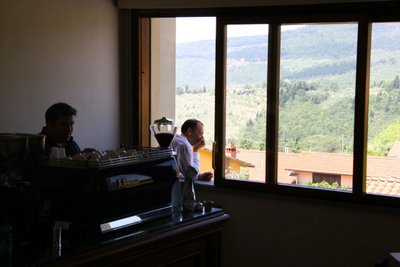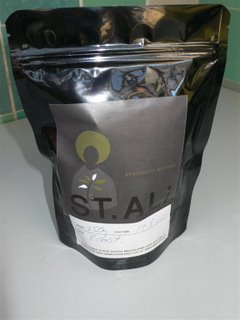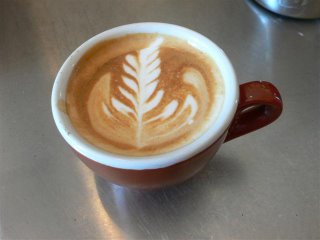One of the reasons why I felt compelled to start up this blog is simply that I am lucky enough to be able to play around with an extraordinary variety of machines, each of which produces a relatively different cup. Seeing as I usually make reference to the coffee preparation conditions, I thought that I might take y'all, beloved readers, through this week's lineup to help put future coffee notes in context.

These are the machines that I will probably refer to most commonly in my posts. After all, they're at home! The Silvia is does the lion's share of the work at home. The combination of rancilio machines is, however, ruthlessly unforgiving.
To make it easier to nail the right temperature, I made a custom backsplash panel to hold a digital thermometer with the probe on top of the boiler. Seeing as QLD Mark showed that convection currents in the boiler only really stop about two minutes after the element light is off, my current technique involves adding more heat by flipping on the steam switch on for a few seconds if necessary immediately after the element goes off, then waiting until the values on the thermometer stop changing. For the mathematically inclined out there, I guess that that means that I'm technically looking at the derivative ... which makes me 1/3rd of a PID controller ;P I'm also using the stock La Marzocco double basket.
Shots from the Silvia and Rocky combo vary greatly in both quality and character. If one purges the wand a lot and starts starts steaming before the steam tstat switches the element off, it is possible to get more ample steam than most of the prosumer HXs that I have tried, but it is wetter.
The La Peppina is even more esoteric! It is a 1970s gravity-fed, spring lever machine. If you thought Rancilio's crappy thermostats were dodgy, be glad that your machine wasn't made by FE-AR; there is no attempt to control temperature whatsoever. You flick the switch on and the element turns on. That's all there is to it. Fortunately, with the lid off, temperature in the area where the brew water is sucked into the piston falls at a rate of about 0.1C/second, so it is possible to repeatedly get something like the temperature that you want. The lever also provides an interesting level of control ... I tend to let it pre-infuse the puck a little bit, then push the lever down to make sure that I've got a full single shot's worth of water flowing through. I can also increase the brew pressure by pushing the lever up to help the spring along. This machine provides great control over all aspects of brewing, but does require a bit of finesse.

Shots from the Peppina generally exhibit very clean flavours, tending towards the more acidic end of the spectrum, as opposed to the more chocolatey. The espresso can easily be thin in body unless you dose up and grind fine, and the crema always seems to fade to a few mm very quickly (unless you make a shot that tastes like garbage to optimise the crema). This machine is espresso only!

... so every now and then I go from my crappy home machines to what must be one of the best machines in the world. If espresso machines were knives, this would be a scalpel, whereas my home machines would be plastic picnic knives. If I were doing surgery, I know which I would choose! This machine derives its amazing flexibility from the multiple-boiler system. Each boiler is controlled by the PID underneat the drip tray ... which I should have cleaned out before taking this photo ;P Because of this, we are able to keep two groups dialled in for the house blend and use the third group to play around with whatever we happen to have around in our play grinder. The levers have a line pressure preinfusion position and a brew position. And you can turn them off, too, I guess.
Shots from the synesso exhibit amazing clarity of flavour and can be tweaked to get out pretty much any characteristics that your blend has. Sometimes, when we have time, we'll assault random enthusiastic customers with the same blend brewed at two different temperatures a few degrees apart ... they are invariably amazed by the difference. However, this machine gives you no room to hide with crap beans. If they are under roasted, they will taste sour and grassy. If they are over-roasted, they will taste charred and like vodka. If the blend has five great beans and one crap one, you'll taste the crap one. The Synesso steams like a train. At low pressures, the stock tip just doesn't cup it. The steam boiler is also PID controlled and we have it running at something like 1.4 bar! Slip up and you paint the walls!

The La Marzocco Linea is a classic. To my mind, only the e-61 is more iconic. The linea is the weapon of choice for many, many high-volume espresso bars across the world; and with good reason - they just won't die. This little trooper didn't miss a beat when we ran about 25kg through it at this year's Aroma Festival in Sydney. In about seven hours! That said, there's a tendency to deify Lineas. The truth is that the Linea has had a long production run. There are a lot of subtle differences between the different models; some are just OK, some are absolutely fantastic. One thing that springs to mind is the gicleurs. Gicleurs (or restrictors) are essentially a bit of metal with a hole through it. The hole determines how long it takes the machine to ramp up to full brew pressure. The smaller the diameter, the gentler the pressure rampup. The second obvious thing is the temperature control. As well as getting lineas at a relatively cheap price, Lineas come standard with PID in Australia. Dave Makin's Linea has 0.6mm gicleurs and does not have a PID.
Shots from the linea tend to be clean, with a relatively rich mouthfeel. Again, this thing has copious steam. Dave's linea exemplifies the adage that no matter how expensive the machine, a large part of its steaming capacity comes down to a $20 steam tip. I don't like the stock tip much, but swapping it with the Reneka Viva S tips makes it dead easy.
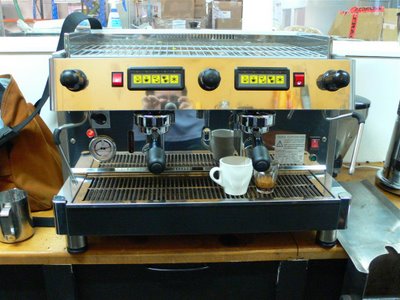
Although we all love the Linea, Veneziano is a roastery that supplies equipment. The vast majority of cafes out there aren't prepared to pony up the dough for a LM or a Synesso, and fair enough. Venez have had just about every HX machine under the sun go through, in a quest for something excellent and reasonably priced. I gather that Pete and Angelo often have to do a bit of internal tweaking to get the machines to perform how they want them to. So it's unsurprising that they have finally just gone and gotten a machine built to their specs so that, in future, they won't have to waste a lot of time tweaking it. This is the BFC machine that I mentioned a few posts ago. It is in the standard 'Diadema' case, which is somewhat poxy, but the internals are right. It's fun to have access to heaps of different machines!
Shots from this BFC machine are very rich and chocolatey, with all of the blend components mingling together to present one uniform flavour. It is understandable that this is what most cafe owners would want; consistency. You can use a blend with a bit of robusta in it to give you a bit more margin of error and you won't pick it up like you would on a Synesso. Nice. This, and the Dalla Corte machines, are my current favourite steamers. It is probably 100% down to the steam arm and tip, which I presume are stock parts used by both manufacturers. People who are ridiculously busy might want more steam. This can be cured with a $20 steam tip. (Sidebar; you wouldn't believe the amount of rebranding and identical parts used by different manufacturers - at least BFC acknowledge this and are happy to get the parts that you want.)
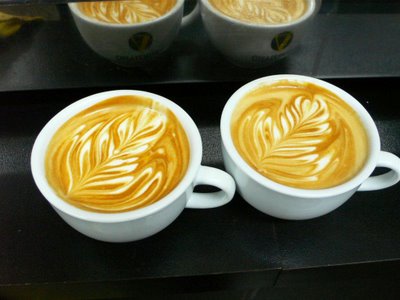
One of my first pours on the new BFC. Usually I screw up the first few jugs on a new machine!

Finally, we come to Dave's Maver machine. This is a little prosumer HX. Again, the thermosyphon has been balanced to require almost no cooling flush, which is a definite plus in my books. The drip tray is massive and the whole thing is made with what seems to be the same quality stainless that the ECM Giotto is made of. In fact, the story behind this machine really parallels the BFC machines - Dave visited Maver, told them what he wanted and they did it for him. Again, most manufacturers use the same parts ... expobar uses a non-e-61 group that has too much preinfusion time for my liking, but, other than that, I can't think of any majorly important differences in parts between most machines in this class. Having a machine like this at home certainly would be fun ... and infinitely preferable to a silvia!
Interestingly, the handful of shots that I have had from the Maver have tasted somewhere between shots from the Linea and shots from the BFC. There is some clarity and nuance, as well as some mega-chocolatey mouthfeel, but it's not like I have done a detailed comparison of all of the machines with the same blend - just my impression. What is really great, though, is that the machine is mega-forgiving. I pulled one shot with Primo that came out as a mega-ristretto and still tasted very clean and chocolatey. As you can imagine, steaming is a bit more anemic than all of the other 15+ litre steam boiler machines that I have mentioned, but no more so than with the other 'prosumer' HXs. The tip that it came with wasn't too impressive until we clogged up some of the holes with toothpicks, at which point it was awesome. I gather that Dave has sourced some different tips. I have taken a new job with Venez that will start sometime next month, part of which will be machine sales, so it's nice to have a machine that will sell itself! The whole 'prosumer' class of machines is something quite novel to me, so I'm looking forward to ripping this one open and tinkering with its ticker.
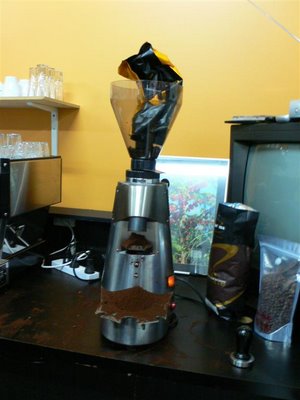
As an addendum, I should mention the Brasilia Competition grinder, just because it's relatively esoteric. This is probably my favourite grinder of all time. All grinders have flaws. With this grinder, the major problem is the incredible amount of mess - take a look at the day's worth of it above! Apparently there's a new exit spout kit around that should remedy this. Anyhoo, it is basically a stepless, doserless, conical burr grinder. Importantly, the grounds seem to pretty much drop straight out of the burrs. This means that they are very fluffy and clump-free, but also prone to spray around a bit. And the thing is fast! I'm looking forward to trying out the new compak K3 doserless, which seems to be like a flat-burred domestic version of this at a price that's only a bit more than a rancilio rocky. Here's hoping ...
Wow! I wrote a fair bit ...
OK, I'll keep it short and close with a thought; although there are some machines that just plain suck and some that are awesome, the differences in shot quality that I have talked about above are often quite subtle. As always, the beans that you are using and the grind/dose/tamp will make
far more difference than the machine itself.
Labels: Gear
 About the coffee: The Daterra sweet collection certainly has a reputation to live up to. From memory, coffee from this cooperative has been an ingredient of the winner's World Barista Competition blend in each of the last three competitions. Klaus Thomsen, this year's WBC, certainly used it as part of his two-bean blend (the other was Costa Rican Hacienda La Minita). Various Daterra coffees also get the stamp of approval from at least three Aussie coffee roasters who I respect a great deal; Mark from St Ali, Peter from Veneziano and Tony from Rio in Adelaide, who has used some Daterra stuff in Mecca Espresso's blend.
About the coffee: The Daterra sweet collection certainly has a reputation to live up to. From memory, coffee from this cooperative has been an ingredient of the winner's World Barista Competition blend in each of the last three competitions. Klaus Thomsen, this year's WBC, certainly used it as part of his two-bean blend (the other was Costa Rican Hacienda La Minita). Various Daterra coffees also get the stamp of approval from at least three Aussie coffee roasters who I respect a great deal; Mark from St Ali, Peter from Veneziano and Tony from Rio in Adelaide, who has used some Daterra stuff in Mecca Espresso's blend.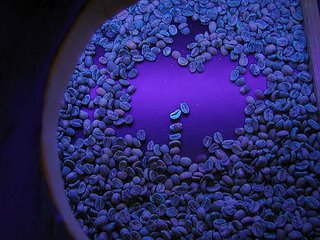 The cooperative is absolutely cutting-edge. Rather than waxing lyrical about their sustainability, research and education programs, I'll just direct you to the Daterra webpage to have a look around. It is very succinctly written. Go ahead. I'll fix myself a coffee while you're gone.
The cooperative is absolutely cutting-edge. Rather than waxing lyrical about their sustainability, research and education programs, I'll just direct you to the Daterra webpage to have a look around. It is very succinctly written. Go ahead. I'll fix myself a coffee while you're gone.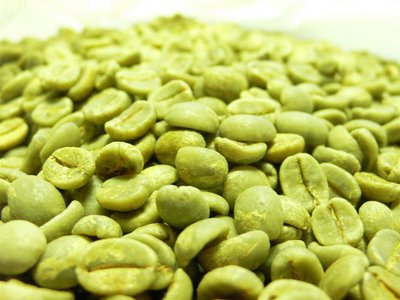 Nicely processed, very even screen size, guaranteed 11% moisture content ... not hard to see why roasters like this coffee! It even seems to photograph easily ...
Nicely processed, very even screen size, guaranteed 11% moisture content ... not hard to see why roasters like this coffee! It even seems to photograph easily ...













